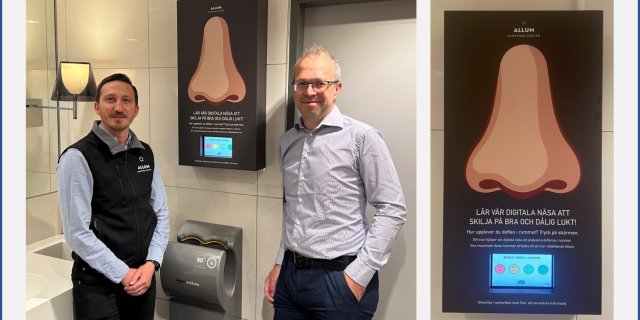
WORLD PREMIERE OF DIGITAL NOSE AT ALLUM SHOPPING CENTER
Allum Shopping Center is the first in the world to test a digital nose in the customer restrooms. Allum welcomes approximately 5 million visitors annually. The digital nose is designed to learn what smells good and what doesn't. “We are thrilled to be the first in the world with the digital nose. We hope our guests will continue to enjoy Allum and our restrooms”, says Albert Aguilar, Shopping Center Manager at Allum.
For Allum, it is crucial that customers experience a clean, accessible, and fresh environment, including the toilets. Essity has been enlisted by Shopping Center Manager Albert Aguilar to develop the business and digitize the cleaning process.
The digital nose has the potential to add another level of data to help us clean even smarter, manage resources, and achieve higher quality levels for our visitors, says Albert Aguilar, who was contacted by Essity with the idea of a digital nose
Our Tork Vision Cleaning system for data-driven cleaning includes sensors in paper and soap dispensers. With the help of these sensors, along with visitor counters, we assist cleaning staff in more efficiently utilizing their time for targeted cleaning. We are always looking for ways to enhance the system, and the digital nose at Allum is one such example. We understand that air and scent play a vital role in the overall experience. Perhaps cleaning can be initiated when a signal of bad odor is received? says Håkan Lindström, Global Technical Innovation Manager at Essity.
How the Digital Nose Works The digital nose involves a modern sensor that measures volatile organic compounds (VOCs), which are general indoor air pollutants. It can detect everything from odors to bad smells. Toilet visitors can indicate their perceived scent by pressing buttons, and this information is registered. The registered smells from the digital nose’s sensor are then compared statistically with the visitors’ button selections.The goal is to link the perceived sensation with the measured values, enabling the sensor to learn through artificial intelligence what smells good and what smells bad. During the summer, two students from Chalmers University of Technology will analyze all the data and compile a report that the company can utilize in other locations.
Once the sensor has memorized what constitutes a bad smell, a message is sent from the toilet to the cleaning staff’s iPads, indicating that cleaning is needed. This technology enables more efficient cleaning, says Albert Aguilar.
The digital nose is still in the testing phase. Can we correlate the perceived sensation with the measured sensation? That’s what we are currently testing. We hope this will work to create a fresher experience in all public spaces, where scent plays a significant role. Many people want it to smell fresh but not perfumed, and we believe this will be a fantastic tool, adds Håkan Lindström.